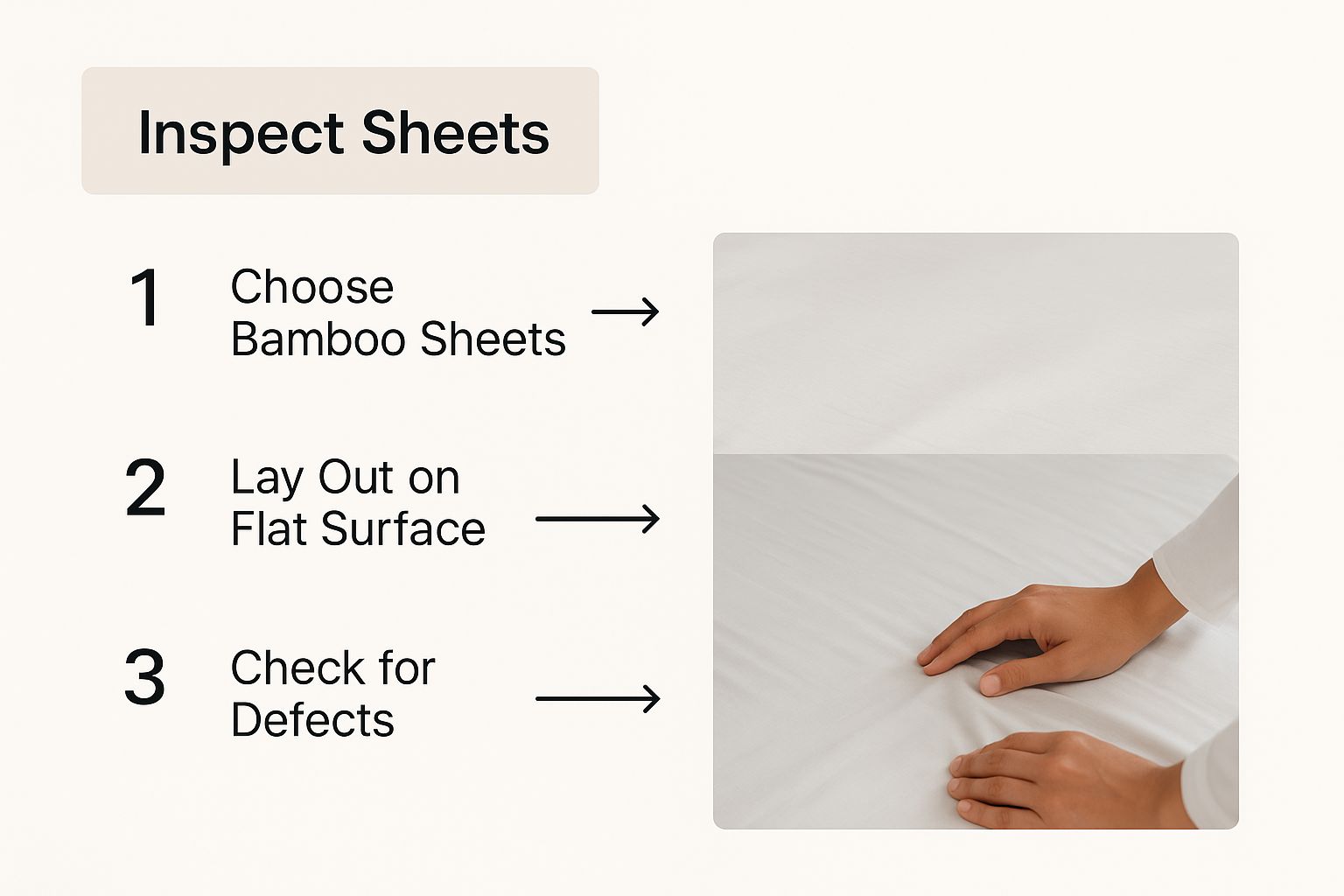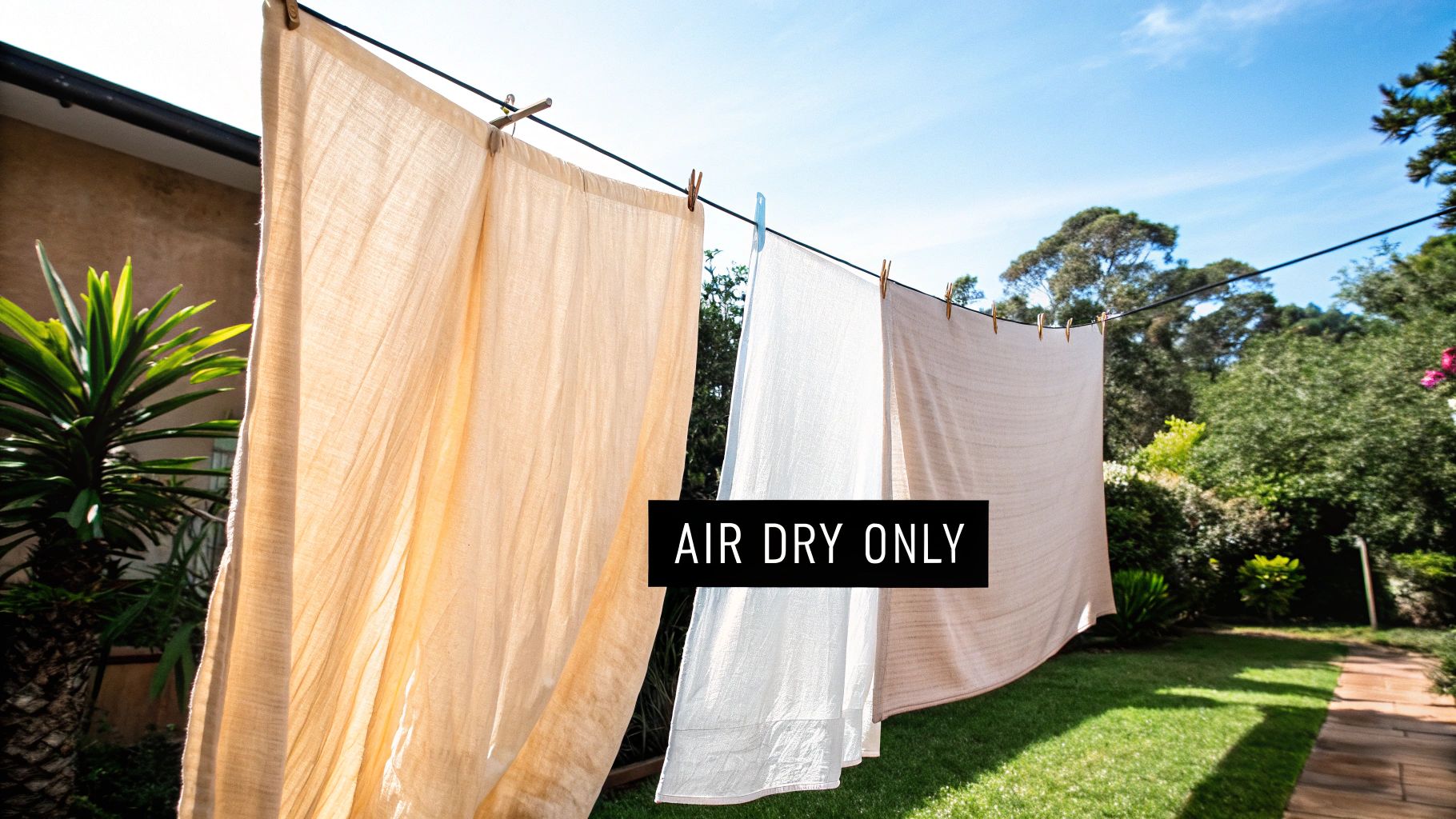So, you've invested in a set of wonderfully soft bamboo sheets. Fantastic choice! Now, you're likely wondering how to wash bamboo sheets to keep them feeling silky smooth. The great news is, it's simple. The secret lies in a gentle wash cycle with cold water and a mild, pH-neutral liquid detergent. This simple routine is the single most important thing you can do to protect the delicate fibres and preserve that signature luxurious feel for years to come.
Why a Special Wash Routine Matters
You likely chose bamboo sheets for their incredible comfort and eco-friendly qualities. To maintain that "like-new" luxury, a specific wash routine is essential. The unique structure of bamboo fabric is what makes it so soft, but it also means it's more delicate than a standard cotton set. A little extra care truly goes a long way.
Unlike rugged fabrics like denim, bamboo fibres react poorly to high heat and harsh chemicals. Following the right method helps you avoid common issues like shrinking, pilling (those annoying little fuzzballs), and a loss of softness.
The Core Essentials: Your Quick Guide
For the best results, focus on these three key elements:
- Water Temperature: Always use cold water. Hot water is the enemy of bamboo fibres, causing them to shrink and weaken over time.
- Machine Cycle: Select the gentle or delicate cycle. The slower agitation is crucial for preventing the fabric from stretching or tearing.
- Detergent Choice: Stick to a mild, pH-neutral liquid detergent. Avoid powdered detergents, bleach, and fabric softeners, as they can damage the fibres and leave a stiff residue.
Bamboo Sheet Washing At a Glance
This table summarises everything you need for a perfect wash. Think of it as your cheat sheet before you press 'start'.
| Setting / Item | Recommended Action | Why It's Important |
|---|---|---|
| Water Temperature | Cold (ideally 30°C or below) | Prevents shrinking and protects the natural fibres. |
| Machine Cycle | Gentle / Delicate | Minimises stress and friction, preventing pilling and tears. |
| Detergent | Mild, pH-neutral liquid | Cleans effectively without stripping or damaging the delicate fabric. |
| Separation | Wash separately or with similar soft items | Avoids abrasion from rough items like towels or zippered clothing. |
Following these simple guidelines ensures your sheets come out clean, soft, and ready for another peaceful night's sleep.
According to Australian textile care experts, the recommended practice for washing bamboo sheets is using cold water—typically 30°C or below—on a delicate machine cycle. This technique is critical for preventing shrinkage and preserving the fabric's softness and durability. You can find more details about these local care standards from Ecoy.
Getting the hang of this simple routine is the first step. If you're curious to learn more about what makes this fabric so special, feel free to explore our complete guide on everything you need to know about bamboo sheets. Mastering this process means your bedding will stay a soft, inviting sanctuary for years to come.
Preparing Your Bamboo Sheets for The Wash
A successful wash starts before your sheets even touch the water. A little prep work is non-negotiable if you want to maintain that signature softness and ensure your sheets last for years. These simple pre-wash steps make all the difference.
First, always wash your bamboo sheets by themselves. It’s tempting to throw everything in together, but heavy items like towels, denim, or anything with zips and buttons can be disastrous. The constant friction against these rougher materials will snag the delicate bamboo fibres, causing pilling and ruining the silky-smooth feel.

Giving your sheets a quick check before they go into the machine helps you spot any little issues before they become permanent problems.
How to Handle Stains
Life happens, and stains are inevitable—whether it’s a splash of morning coffee or natural body oils. The trick is to act fast.
Whatever you do, step away from harsh chemical stain removers and bleach. They are far too aggressive for bamboo fibres and can cause irreversible damage, weakening the fabric and causing discolouration.
Real-World Example: Imagine you've spilled some tea on your pillowcase. Don't panic and start scrubbing. Instead, gently blot the excess liquid with a clean cloth. Then, mix a small amount of your mild liquid detergent with cool water, dab it onto the stain, and let it sit for 15-20 minutes before washing as usual. This gentle method lifts the stain without stressing the fabric.
If you're looking for more tips on making your sheets last, we have a comprehensive guide on how to care for your bamboo sheets so they last for years.
The Right Settings and Soap for Your Bamboo Sheets
The settings you choose and the soap you pour make all the difference. Getting these details right is the secret to keeping your bamboo sheets silky smooth, wash after wash.
Always reach for the cold, gentle cycle on your machine. In most Australian washers, a 'cold' wash is around 30°C or lower. This cool temperature is non-negotiable; it stops the delicate bamboo fibres from shrinking or getting damaged. Pairing it with a gentle cycle reduces friction, which helps prevent stretching and pilling.
Picking the Perfect Detergent
Choosing the right detergent is simple once you know what to look for. Your goal is to get your sheets clean without causing harm.
Your best bet is a mild, pH-neutral liquid detergent. Powdered detergents often don't dissolve properly, leaving a gritty residue that can make your soft sheets feel stiff and scratchy. Some also contain optical brighteners, which can break down the bamboo fabric over time.
Be sure to avoid:
- Fabric softeners: They coat the fibres, clogging them and ruining their natural breathability and moisture-wicking properties.
- Bleach: Both chlorine and oxygen-based bleaches are too aggressive and will cause permanent damage.
- Harsh stain removers: Stick to the gentle pre-treatment methods mentioned earlier.
A 2023 consumer report found that over 75% of bamboo bedding owners who switched to gentle, biodegradable detergents noticed their sheets maintained their softness for at least a year longer than those using standard detergents. This highlights the link between eco-friendly habits and smarter fabric care. You can learn more about these eco-friendly laundry habits.
Pro-Tip: Consider adding an extra rinse cycle. This simple step ensures every last bit of detergent is washed away. Leftover soap residue is the most common reason for sheets feeling stiff after a wash. If you have more questions, our bamboo bedding FAQ is a great resource.
How to Dry Bamboo Sheets to Keep Them Soft
You've washed your sheets perfectly—now what? How you dry them is just as crucial for maintaining that incredible silky-soft feel.
The biggest mistake you can make is using too much heat. High temperatures will literally cook the delicate threads, causing them to shrink, become brittle, and lose their signature softness.

Luckily, the best drying methods are also the simplest.
Line-Drying: The Gold Standard
Honestly, the best thing for your bamboo sheets is the classic clothesline. This gentle, zero-cost method uses nothing but fresh air, leaving your bedding feeling incredibly fresh. A bit of sun is also a natural sanitiser that helps keep whites bright, but avoid harsh direct sunlight which can fade colours.
For best results, give each sheet a firm shake before hanging it up. This helps remove major wrinkles from the start. Drape them evenly over the line to let air circulate freely, speeding up drying time and preventing stiffness.
Using a Tumble Dryer Safely
If you must use a tumble dryer, stick to the lowest heat setting available. An 'air dry' or 'no heat' cycle is your best bet. A recent study found that over 60% of fabric damage complaints for specialty bedding were traced back to improper drying temperatures.
Practical Tip: Toss a few wool dryer balls into the drum with your sheets. They are brilliant for separating the fabric, which improves airflow and helps everything dry faster and more evenly. They also act as a natural fabric softener and reduce static.
Choosing the right drying method is the final, crucial step in your routine for how to wash bamboo sheets. Get this part right, and you'll ensure they stay as soft and inviting as the day you first brought them home.
7 Common Mistakes to Avoid When Washing Bamboo Bedding
Even with the best intentions, a few simple missteps can shorten the life of your beautiful bamboo bedding. When you're learning how to wash bamboo sheets, knowing what not to do is just as important as knowing the right steps.
Let's walk through the most common errors so you can easily sidestep them.
1. Using Fabric Softener
This is the big one. It seems counterintuitive, but fabric softener is the enemy of bamboo fabric. It works by coating the fibres with a waxy residue. On bamboo, this clogs the natural pores, stripping away their amazing breathability and moisture-wicking properties—the very reasons you invested in bamboo bedding in the first place!
2. Overloading the Washing Machine
Another frequent pitfall is overloading the machine. When the drum is too full, it creates excess friction between items, causing pilling and stressing the delicate seams. Your sheets need room to move freely to get properly cleaned and thoroughly rinsed.
3. Using Hot Water
Using hot water is a definite no-go. High temperatures are harsh on bamboo's fine fibres, causing them to shrink, weaken, and become brittle. This damage is irreversible. Always stick to a cold or cool wash.
4. Choosing the Wrong Stain Remover
Reaching for the wrong stain remover is a fast track to ruining your sheets. Harsh chemicals like chlorine bleach or products with hydrogen peroxide are too aggressive for bamboo. They can break down the delicate fibres and even lead to permanent yellowing.
To keep your bedding pristine, always use gentle, pH-neutral detergents and enzyme-based stain removers made for delicates. Our frequently asked questions guide is a fantastic resource for more tips.
Common Washing Mistakes and Their Solutions
| Common Mistake | Why It's Harmful | What to Do Instead |
|---|---|---|
| Using Fabric Softener | Coats fibres, reducing breathability and softness over time. | Add half a cup of white vinegar to the rinse cycle for natural softening. |
| Washing in Hot Water | Causes fibres to shrink, weaken, and become brittle. | Always wash in cold water (max 30°C) on a gentle cycle. |
| Using Harsh Chemicals | Bleach and strong detergents break down bamboo fibres and cause yellowing. | Use a gentle, pH-neutral liquid detergent. Spot-treat stains with a mild, enzyme-based cleaner. |
| Overloading the Machine | Increases friction, leading to pilling and potential damage to seams. | Wash sheets on their own or with other bamboo items. Don't crowd the drum. |
| Washing with Rough Items | Zips, hooks, and coarse fabrics can snag and tear the delicate weave. | Wash bamboo bedding separately from towels, denim, or clothing with hardware. |
| Using a High Spin Cycle | The intense force can stretch and stress the fibres unnecessarily. | Select a low spin setting on your machine. |
| Drying on High Heat | The number one cause of shrinking and fibre damage. | Line dry for best results, or tumble dry on the lowest heat/air-dry setting. |
Steering clear of these simple errors is the best way to guarantee your bamboo sheets stay soft, silky, and beautiful for years.
Your Bamboo Sheet Care Questions Answered
Even with a perfect routine, specific questions can pop up. Here are the most common ones we hear, with straightforward, actionable answers.

How Often Should I Wash My Bamboo Sheets?
In Australia, washing frequency often depends on the season.
During warm, humid summer months, washing them weekly is best to handle the natural build-up of sweat and body oils.
In cooler, drier seasons, you can stretch it to every 10 to 14 days. Over-washing can put unnecessary stress on the fibres, so find the sweet spot that works for you.
Can I Use Vinegar or Baking Soda?
Yes, absolutely! They are fantastic, natural alternatives to harsh chemical softeners.
- White Vinegar: Add half a cup to your machine’s final rinse cycle. It dissolves leftover detergent residue, which is often what makes fabrics feel stiff.
- Baking Soda: Add a quarter-cup to the main wash to help deodorise and gently brighten your sheets.
Just use them in moderation. They are excellent tools for keeping your bedding fresh and luxuriously soft.
Why Do My Bamboo Sheets Feel Stiff After Washing?
This common problem almost always comes down to two culprits: leftover detergent residue or drying with too much heat.
The fix is usually simple. Try using a little less detergent and select the 'extra rinse' cycle on your machine. This ensures every trace of soap is washed away. If using a tumble dryer, make sure it’s on the lowest heat or an 'air dry' setting. High heat can 'bake' the fibres, ruining their softness for good.
If you have more questions, we’ve put together a comprehensive guide covering even more ground. You can find more details in our frequently asked questions about bamboo bedding.
Keep Your Bamboo Sheets Feeling Brand New
Mastering how to wash bamboo sheets is simple. By using a gentle, cold wash cycle, a mild detergent, and avoiding high heat, you protect your investment and ensure every night is as comfortable as the first. This small effort pays off in long-lasting softness and durability.
Ready to experience the lasting luxury of perfectly cared-for bamboo bedding? Explore our collection of premium bamboo bedding and find your perfect set today.

